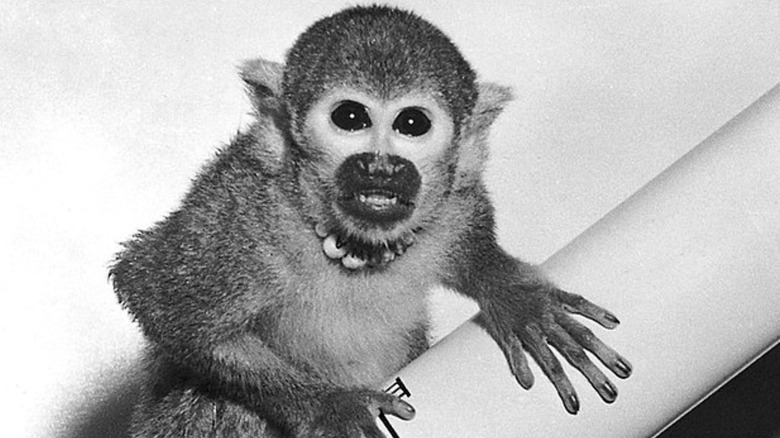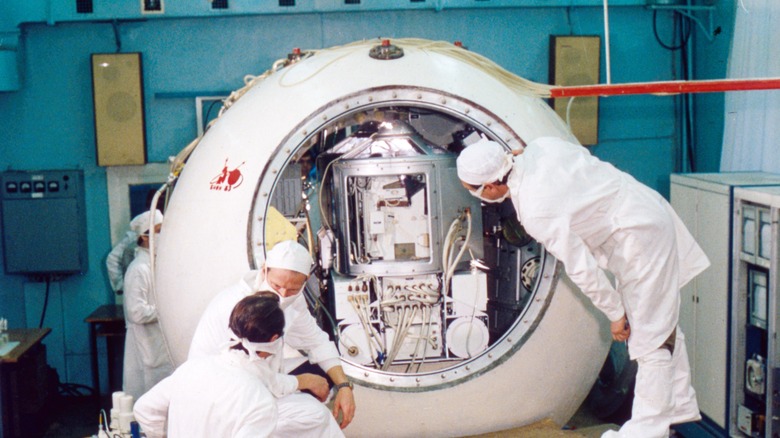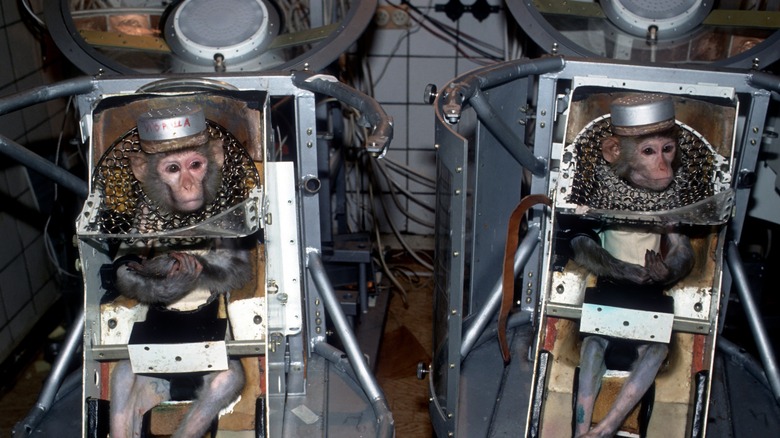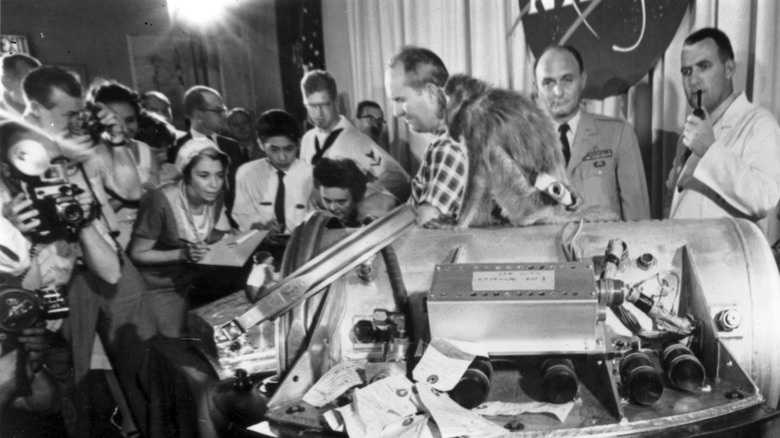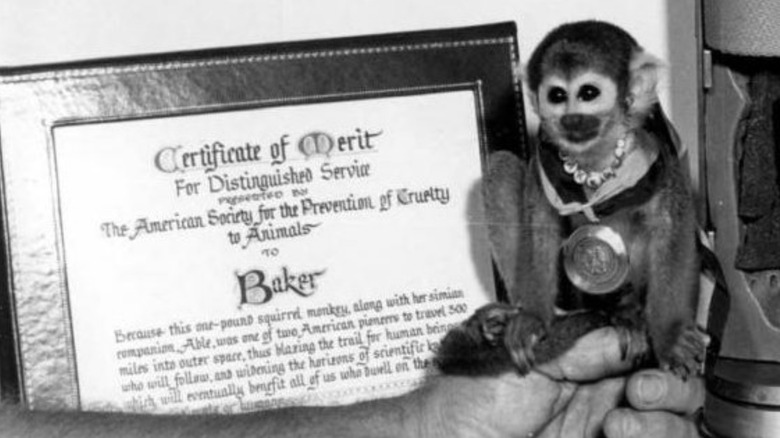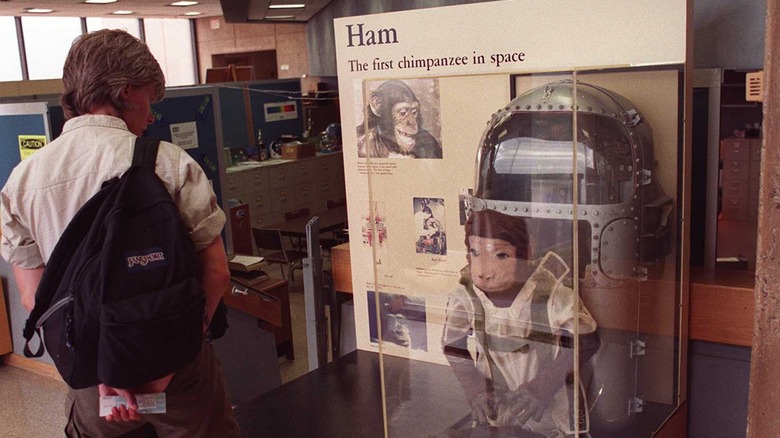The Truth About The First Successful Monkeynauts From The US
Most people either remember or have learned about NASA's Apollo missions. The Apollo program, with three astronauts together in the capsule, followed the first U.S. manned space flights — Mercury, with one astronaut on board, and Gemini, with two men in flight. During Apollo 11, Neil Armstrong became the first astronaut to step foot on the moon in 1969. Apollo 13's disaster nearly ended in astronaut fatalities (per space.com).
However, one of the biggest concerns about space flight before the Apollo missions was what space would do to the human body with such long periods of weightlessness, according to NASA. Just as monkeys are often used in experiments to test vaccines and other medical treatments because of their close proximity to humans as a fellow primate, space researchers decided to send monkeys into space to test whether they could survive this weightlessness and return safely back to earth. As a result, before the first human astronauts traveled outside the planet, it was the monkeynauts that truly paved the way for space flight.
The first monkeynauts
In 1948, the first-ever primate was launched in a rocket based in White Sands, New Mexico, according to NASA. Because the mission wasn't well-documented, Albert I, a rhesus monkey in the macaque family, wasn't granted much recognition for his bravery. Following Albert I was Albert II, who got slightly more press the following year for making it 83 miles into space, but he died on impact when he returned to earth (via NASA). Afterwards, a host of other monkeys, dogs, and mice were launched, but all underwent some form of sickness or health effects, or else died on impact (per NASA).
It wasn't until 1951, in a flight out of New Mexico, that the first monkey to be sent into space survived the space flight. Yorick soared 236,000 feet into the air along with 11 mice, per NASA. However, the Kármán line, or the point where earth's sky technically transitions into outer space, is about 50 miles up, or 264,000 feet, according to National Geographic, so many of these early monkeynauts can't quite be called the Neil Armstrong of the monkey world.
Able and Baker
During this time, the U.S. was competing with the Soviets in the space race, so there were many monkeys being launched in rockets with deadly consequences. As a result, animal rights activists were getting stirred up, and there was more and more on the line to have a successful animal space mission, according to The Sunday Post. In 1959, a rhesus monkey and a squirrel monkey, named Able and Baker, respectively, were launched into space at 100,000 miles an hour, according to The Tuscaloosa News. Baker caught the eyes of researchers and was selected because of "her intelligence and loving, docile manner," per The Sunday Post. According to Vox, the research team nicknamed her TLC, for her "tender, loving, care."
Ultimately, she and Able soared to a peak of 300 miles — officially reaching the space realm — before returning to earth unharmed, per NASA. Altogether the pair were floating weightless in space for nine minutes, which gave the human scientists back on earth lots of data on how a primate's cardiovascular systems reacted to space travel. Their contributions to science were lauded, unlike many of the monkeynauts that came before them, and they made it on the cover of Life Magazine, according to Huntsville.org.
Just the beginning for Miss Baker
Unfortunately, Baker's partner monkey, Able, died when researchers tried to remove an electrode used for testing from her body after the flight (via Huntsville.org). But Baker — who became known as "Miss Baker" — was only two years old at the time of the space journey. She had a long life to live and went on to become a local celebrity (per Huntsville.org).
Miss Baker, enjoying the life of retirement from space flight, settled into domestic life. In 1962, she "married" her first husband, fellow squirrel monkey Big George, according to the U.S. Space & Rocket Center (posted on YouTube). But it was time for a change of scenery for Miss Baker, and she was recruited by zoos in Washington and San Diego, as well as the Kennedy Space Center in Florida. Ultimately, she was transferred to the Alabama Space & Rocket Center in Huntsville in 1971 (via U.S. Space & Rocket Center).
The first lady legacy
In Alabama, Miss Baker started getting tons of fan mail. As the "first lady" in space, she received more than 100 letters a day and required her own secretary (via The Tuscaloosa News). Big George died in 1979, so Miss Baker was teamed with a new companion, Norman, and they, too, "married" three months later (via the U.S. Space & Rocket Center). In typical celebrity style, Miss Baker didn't seem to be a fan of the traditional formalities of the ceremony and ripped off her white wedding train before the ceremony took place (per Huntsville.org).
Throughout her life, Miss Baker appeared on 20 television shows before ultimately dying from kidney failure at the age of 27 (via Huntsville.org). Her age broke another world record, and she was named the oldest living squirrel monkey in history, reaching the human equivalent of over 100 years old and surpassing the life expectancy of squirrel monkeys by 10 years (via Huntsville.org). Today, many still pay tribute to Miss Baker by laying a banana on her grave in Huntsville, Alabama (per Vox).
Ham the Chimp
While Miss Baker was enjoying retirement, a chimpanzee named Ham was being prepared for his own space mission. Perhaps more well-known than the monkeynauts, this "astrochimp" was launched into space in 1961 (via Life). Unlike the smaller monkeys, which were sent into space in tiny capsules where they couldn't move, Ham was assigned various space craft tasks to make sure they would work for human astronauts that came after him (per Life). After his successful mission, he touched down in the ocean and was unscathed (per The Guardian).
However, some view the smile he gave the cameras as a look of terror, and the humaneness of experimenting with chimps and other monkeys for space flight has since been disputed (via The Guardian). Ham didn't get the same celebrity treatment as Miss Baker and spent the next 20 years in solitude at a zoo in Washington, D.C. (via The Guardian). Today, all that remains of him are his bones, piled in a display case at the U.S. National Museum of Health and Medicine, and perhaps the memory of his cheeky grin when he touched down from space.
